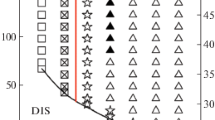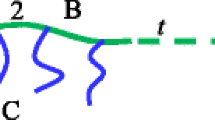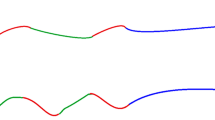Abstract
The general density functional approach is used to develop a molecular-statistical theory of rod-coil diblock copolymers which is valid in the case of both weak and strong segregation. The free energy of the rod-coil copolymer is expressed as a functional of the number densities of rod and coil monomers which depend on the translational and orientational degrees of freedom. The equilibrium densities are determined by minimization of the free energy functional and depend on the orientational and translational order parameters of the monomers. The order parameters are calculated numerically by minimization of the free energy taking into account the incompressibility condition within the formalism of Lagrange multipliers. Phase diagrams are obtained and the profiles of orientational and translational order parameters are presented as functions of temperature and the fraction of coil fragments. It is shown that the lamellar phase possesses strong orientational order and the stability of the phase is increasing with the increasing fraction of rod monomers.





Similar content being viewed by others
REFERENCES
R. A. Segalman, B. McCulloch, S. Kirmayer, and J. J. Urban, Macromolecules 42, 9205 (2009).
G. Yu, J. Gao, J. C. Hummelen, F. Wudl, and A. J. Heeger, Science 270, 1789 (1995).
Y. Tao, B. McCulloch, S. Kim, and R. A. Segalman, Soft Matter 5, 4219 (2009).
C. L. Chochos, J. K. Kallitsis, and V. G. Gregoriou, J. Phys. Chem. B 109, 8755 (2005).
S. Becker, C. Ego, A. C. Grimsdale, E. J. List, D. Marsitzky, A. Pogantsch, S. Setayesh, G. Leising, and K. Mullen, Synth. Met. 125, 73 (2001).
Y. Tao, B. Ma, and R. A. Segalman, Macromolecules 41, 7152 (2008).
H. M. Konig, T. Gorelik, U. Kolb, and A. F. M. Kilbinger, J. Am. Chem. Soc. 129, 704 (2007).
Y. Pae and F. W. Harris, J. Polym. Sci., Part A: Polym. Chem. 38, 4247 (2000).
A.-V. Ruzette and L. Leibler, Nat. Mater. 4, 19 (2005).
G. Rabani, H. Luftmann, and A. Kraft, Polymer 47, 4251 (2006).
A. Semenov and S. Vasilenko, J. Exp. Theor. Phys. 63, 70 (1986).
R. Hołyst and M. Schick, J. Chem. Phys. 96, 730 (1992).
M. Reenders and G. ten Brinke, Macromolecules 35, 3266 (2002).
L. Leibler, Macromolecules 13, 1602 (1980).
M. Muller and M. Schick, Macromolecules 29, 8900 (1996).
J.-Z. Chen, C.-X. Zhang, Z.-Y. Sun, Y.-S. Zheng, and L.-J. An, J. Chem. Phys. 124, 104907 (2006).
V. Pryamitsyn and V. Ganesan, J. Chem. Phys. 120, 5824 (2004).
M. W. Matsen and C. Barrett, J. Chem. Phys. 109, 4108 (1998).
Y. A. Kriksin and P. G. Khalatur, Macromol. Theory Simul. 21, 382 (2012).
T. Ohta and K. Kawasaki, Macromolecules 19, 2621 (1986).
T. Uneyama and M. Doi, Macromolecules 38, 196 (2005).
D. Düchs and D. E. Sullivan, J. Phys.: Condens. Matter 14, 12189 (2002).
R. C. Hidalgo, D. E. Sullivan, and J. Z. Y. Chen, J. Phys.: Condens. Matter 19, 376107 (2007).
J. Tang, Y. Jiang, X. Zhang, D. Yan, and J. Z. Y. Chen, Macromolecules 48, 9060 (2015).
W. Song, P. Tang, F. Qiu, Y. Yang, and A.-C. Shi, Soft Matter 7, 929 (2011).
Y. Jiang and J. Z. Y. Chen, Phys. Rev. Lett. 110, 138305 (2013).
S. Li, Y. Jiang, and J. Z. Y. Chen, Soft Matter 10, 8932 (2014).
Y. Cai, P. Zhang, and A.-C. Shi, Soft Matter 13, 4607 (2017).
J. Gao, W. Song, P. Tang, and Y. Yang, Soft Matter 7, 5208 (2011).
J. Gao, P. Tang, and Y. Yang, Soft Matter 9, 69 (2013).
Y. Jiang and J. Z. Y. Chen, Phys. Rev. E: Stat., Nonlinear, Soft Matter Phys. 88, 042603 (2013).
M. A. Osipov, in Handbook of Liquid Crystals (Wiley-VCH Verlag GmbH, Weinheim, 2014) pp. 40–71.
R. Evans, in Fundamentals of Inhomogeneous Fluids (Decker, New York, 1992).
Y. Singh, Phys. Rev. A: At., Mol., Opt. Phys. 30, 583 (1984).
T. J. Sluckin and P. Shukla, J. Phys. A: Math. Gen. 16, 1539 (1983).
L. Longa, J. Stelzer, and D. Dunmur, J. Chem. Phys. 109, 1555 (1998).
A. Perera, G. N. Patey, and J. J. Weis, J. Chem. Phys. 89, 6941 (1988).
I. R. M. Jean-Pierre Hansen, Theory of Simple Liquids; with Applications to Soft Matter (Elsevier LTD, Oxford, 2013).
E. F. David and K. S. Schweizer, J. Chem. Phys. 100, 7767 (1994).
K. S. Schweizer and J. G. Curro, in Advances in Polymer Science (Springer, Berlin; Heidelberg, 1997) pp. 319–377.
A. L. Kholodenko, Ann. Phys. 202, 186 (1990).
A. L. Kholodenko, Macromolecules 26, 4179 (1993).
A. J. Spakowitz and Z.-G. Wang, Macromolecules 37, 5814 (2004).
S. Stepanow, Eur. Phys. J. B 39, 499 (2004).
S. Stepanow, J. Phys.: Condens. Matter 17, S1799 (2005).
X. Zhang, Y. Jiang, B. Miao, Y. Chen, D. Yan, and J. Z. Y. Chen, Soft Matter 10, 5405 (2014).
J. S. Pedersen and P. Schurtenberger, Macromolecules 29, 7602 (1996).
H.-P. Hsu, W. Paul, and K. Binder, J. Chem. Phys. 137, 174902 (2012).
H.-P. Hsu, W. Paul, and K. Binder, Polym. Sci., Ser. C 55, 39 (2013).
H. Wu, L. He, X. Wang, Y. Wang, and Z. Jiang, Soft Matter 10, 6278 (2014).
B. D. Olsen and R. A. Segalman, Mater. Sci. Eng., R 62, 37 (2008).
ACKNOWLEDGMENTS
M.A.O and M.V.G. are grateful to Ya. Kudryavtsev for many interesting discussions.
Funding
The authors are grateful to Russian Science Foundation, Grant no. 19-13-00398 for financial support.
Author information
Authors and Affiliations
Corresponding author
Ethics declarations
The authors declare that they have no conflict of interest.
Self Consistent Equations for the Order Parameters
Self Consistent Equations for the Order Parameters
The phase diagram in Fig. 4 has been calculated by direct substitution of the incompressibility condition into the free energy (51) and subsequent minimization with respect to the order parameters \(\sigma \) and \(S\) and the single translational order parameter \(\psi \):
This minimization yields the following expressions for the order parameters ψ and σ:
and
where the order parameters \({{\psi }_{r}},{{\psi }_{c}}\) and σ are defined by standard equations (39)–(41) as averages of the corresponding microscopic quantities with the one-particle distribution functions. One can readily see that the self-consistency of the theory is broken because it requires \(\tilde {\psi } = {{\psi }_{r}} = - ({{f}_{c}}{\text{/}}{{f}_{r}}){{\psi }_{c}}\) and \(\tilde {\sigma } = \sigma \) which does not follow from these equations. As a result of this inconsistency the order parameter can exceed, for example, the unit value, as can be seen in Fig. 5.
In contrast, it can be shown that the minimization of the free energy (83) with respect to the order parameters \({{\psi }_{r}},{{\psi }_{c}},\sigma \) and S taking into account the equation for λ yields the self-consistent equations for all order parameters which directly correspond to their general definitions given by Eqs. (39)–(41).
Rights and permissions
About this article
Cite this article
Osipov, M.A., Gorkunov, M.V. & Antonov, A.A. Density Functional Approach to the Molecular Theory of Rod-Coil Diblock Copolymers. Polym. Sci. Ser. A 62, 562–577 (2020). https://doi.org/10.1134/S0965545X20050132
Received:
Revised:
Accepted:
Published:
Issue Date:
DOI: https://doi.org/10.1134/S0965545X20050132




